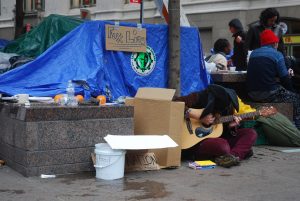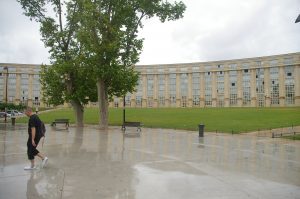By Roger Keil
Although there is some fraying at its many edges and state action has led to some confrontation, eviction, reaction, the Occupy Movement is going strong. Whatever its short term fate, its long term impact has already reached historic proportions. Rarely have the winds of change been so dramatic, universal and hopeful. Revolutions are measured in four digits: 1789, 1848, 1871, 1917, 1968, 1989. 2011 is gearing up to take its rightful place among those iconic years. This is due as much to the Arab Spring as it is to Occupy.
 Among the changes put into motion is the reassessment of how and where we live. The movement has created a new notion of centrality as it has occupied specific symbolic locales where a dense, almost medieval urbanity of transitory structures has nestled into existing built environments. Often, these locations are near or even in the heart of what the French urbanist Henri Lefebvre has called the “decision-making centers” in cities.[1] Not surprisingly, given the focus of Occupy on wealth disparity and the role of the financial sector in creating it, tents were pitched in the face of bank towers, be it in New York or Frankfurt, London or Toronto. Even Winnipeg’s October 15 demo staged itself at Portage and Main, which is as close to a financial core as one can get on the prairies. It is the nerve centres of the global cities that matter in the locational and symbolic placemaking Occupy is engaged in.
Among the changes put into motion is the reassessment of how and where we live. The movement has created a new notion of centrality as it has occupied specific symbolic locales where a dense, almost medieval urbanity of transitory structures has nestled into existing built environments. Often, these locations are near or even in the heart of what the French urbanist Henri Lefebvre has called the “decision-making centers” in cities.[1] Not surprisingly, given the focus of Occupy on wealth disparity and the role of the financial sector in creating it, tents were pitched in the face of bank towers, be it in New York or Frankfurt, London or Toronto. Even Winnipeg’s October 15 demo staged itself at Portage and Main, which is as close to a financial core as one can get on the prairies. It is the nerve centres of the global cities that matter in the locational and symbolic placemaking Occupy is engaged in.
And this may be a problem. Why? Because strategically, Occupy has made its nest in the shadow of the 1 percent in order to bring to light the growing plight of the 99 percent far removed from where the latter live, work and play. Its fixation on centres (where powers, real and medial can be found and will take notice) has the potential of weakening the movement as it grows from protest to organization, an inevitable step if it wants to survive politically.
There is an interesting myth developing around the Occupy sites which fetishizes monolithic centres. The New York Times’ Michael Kimmelman finds “In Protest, the Power of Place”. Sarah Goodyear sees “the creative genius of Occupy Wall Street” and refers to the power of place. Matt Yglesias is more explicit in his emphatic piece on “the burden of the city” where he states: “Nobody wants to occupy the strip mall or the office park or the park and ride lot. Not today and not ever. Core municipalities have a special role as gathering places, focal points, and hubs of activity.” Perhaps this is not the whole story.
Some have begun to spin a different yarn. Peter Marcuse has blogged on the various aspects of space and warned of a “fetishization of space”. Pham Binh quips: “You can’t evict a revolution” noting the place- and spacelessness of revolt. This sounds good but is not true as we well know from the history of revolutions. After cycling around Lower Manhattan in the morning after OWS eviction a decidedly less cheery Goodyear asked exasperatedly and rhetorically: “Where is Occupy Wall Street without Zuccotti Park?” and responds to herself: “The movement has always intended to reach beyond the boundaries of Zuccotti Park. As powerful and useful as that place has been, if the force behind OWS is as powerful as its organizers believe, it will soon spring up somewhere else.” Adds Richard Florida in a tweet on November 15: “The Occupy movement shows the extraordinary role of place in economy & society - nexus of class struggle has shifted from factory to place.” This is doubly surprising. Do the creatives now live in tents? And, how come the factories (of which there are lots) are not places? But this is for another time.
 For now, let’s sit back and realize that our urban world has grown beyond the centres. Centrality now encompasses a different scale. When Lefebvre coined the idea of the “right to the city” as a reaction to the exclusion of the Nanterre students from the promises of Paris, he did not endorse the fetishization of the “decision-making centres”. Rather, he cast a light on the subordination of the peripheries where the "99 percent" of his era of late Fordism worked, studied and mostly lived. There has been a Haussmannian history of evicting the working class from the centre. Clearly what happened in Paris way more than a century ago is now a ubiquitous presence in the gentrified, corporatized capitals of capital of which New York is the prime example. Perhaps there is a strong lesson here: We can increasingly disregard the symbolic but ultimately vacuous power centres of global capital and concentrate on the politics of everyday life where it actually goes on. This might just be in the suburbs and inbetween spaces of our metropolitan areas.
For now, let’s sit back and realize that our urban world has grown beyond the centres. Centrality now encompasses a different scale. When Lefebvre coined the idea of the “right to the city” as a reaction to the exclusion of the Nanterre students from the promises of Paris, he did not endorse the fetishization of the “decision-making centres”. Rather, he cast a light on the subordination of the peripheries where the "99 percent" of his era of late Fordism worked, studied and mostly lived. There has been a Haussmannian history of evicting the working class from the centre. Clearly what happened in Paris way more than a century ago is now a ubiquitous presence in the gentrified, corporatized capitals of capital of which New York is the prime example. Perhaps there is a strong lesson here: We can increasingly disregard the symbolic but ultimately vacuous power centres of global capital and concentrate on the politics of everyday life where it actually goes on. This might just be in the suburbs and inbetween spaces of our metropolitan areas.
A good place to start looking for the politics of change are rather “remote” exurban spaces like Imperial Valley in LA, where Mike Davis has found much determination to put up a fight with a combination of history, place and virtuality. A new centrality indeed. There is much opportunity for enabling in those spaces. And there is room to move into new political arenas that are not tied to the symbolic capital of capital. Let’s occupy the strip malls!
[1] Lefebvre, H. (2003). The Urban Revolution. Minneapolis: University of Minnesota Press.
PS: I have deleted a prior reference to Amanda Erickson’s article “How Occupy Wall Street is Reinventing Public Space” as the post was updated from its original version http://www.theatlanticcities.com/politics/2011/11/How-Occupy-Wall-Street-Reinventing-public-Space/398/


2 comments on ““Occupy the strip malls”: Centrality, Place and the Occupy Movement”